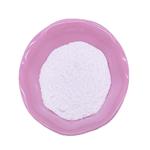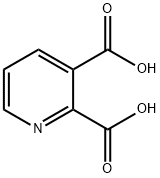Quinolinic acid
- CAS No.
- 89-00-9
- Chemical Name:
- Quinolinic acid
- Synonyms
- PYRIDINE-2,3-DICARBOXYLIC ACID;2,3-PYRIDINEDICARBOXYLIC ACID;QUIN;2,3-Pyridinedicarboxylic;Pyridine-2,3-dicarboxylate;2,3-PyridinedicarboxylicAcid99%;109/KG;NSC 18836;NSC 13127;NSC 403247
- CBNumber:
- CB7316162
- Molecular Formula:
- C7H5NO4
- Molecular Weight:
- 167.12
- MDL Number:
- MFCD00006295
- MOL File:
- 89-00-9.mol
| Melting point | 188-190 °C (dec.) (lit.) |
|---|---|
| Boiling point | 295.67°C (rough estimate) |
| Density | 1.5216 (rough estimate) |
| refractive index | 1.6280 (estimate) |
| storage temp. | Keep in dark place,Sealed in dry,Room Temperature |
| solubility | 10g/l |
| form | Crystalline Powder |
| pka | 2.43(at 25℃) |
| color | White to light yellow-beige |
| Odor | odorless |
| Water Solubility | 0.55 g/100 mL |
| Merck | 14,8073 |
| BRN | 137110 |
| InChIKey | GJAWHXHKYYXBSV-UHFFFAOYSA-N |
| CAS DataBase Reference | 89-00-9(CAS DataBase Reference) |
| EWG's Food Scores | 1 |
| FDA UNII | F6F0HK1URN |
| EPA Substance Registry System | 2,3-Pyridinedicarboxylic acid (89-00-9) |
| UNSPSC Code | 12352100 |
| NACRES | NA.22 |
SAFETY
Risk and Safety Statements
| Symbol(GHS) |  GHS07 |
|||||||||
|---|---|---|---|---|---|---|---|---|---|---|
| Signal word | Warning | |||||||||
| Hazard statements | H319-H335 | |||||||||
| Precautionary statements | P261-P264-P271-P280-P304+P340+P312-P305+P351+P338 | |||||||||
| Hazard Codes | Xi | |||||||||
| Risk Statements | 36/37/38-33 | |||||||||
| Safety Statements | 26-36/37-24/25-37 | |||||||||
| WGK Germany | 3 | |||||||||
| RTECS | US7967250 | |||||||||
| TSCA | T | |||||||||
| HazardClass | IRRITANT | |||||||||
| HS Code | 29333999 | |||||||||
| Hazardous Substances Data | 89-00-9(Hazardous Substances Data) | |||||||||
| Toxicity | Focal injection of quinolinic acid into specific areas of the brain produces neuronal damage although sparing axons of passage. Similarities between the biochemical and morphological profiles of these lesions and human neuropathy seen in neurodegenerative diseases have led to the proposal that endogenous excitotoxins may play a role in such neurodegenerative disease states. Quinolinic acid is an intermediate in the kynurenine pathway of tryptophan metabolism and has been detected in the brains of several mammals including man. The neuroexcitatory action is thought to be mediated via interaction with the N-methyl-D-aspartate (NMDA) receptor of the glutamate family. No mechanism for quinolinic acid removal, nor for synaptic inactivation, has been found, and consequently accumulation of concentrations capa_x0002_ble of inducing neuronal degeneration and death may occur. | |||||||||
| NFPA 704 |
|
Quinolinic acid price More Price(49)
| Manufacturer | Product number | Product description | CAS number | Packaging | Price | Updated | Buy |
|---|---|---|---|---|---|---|---|
| Sigma-Aldrich | P63204 | 2,3-Pyridinedicarboxylic acid 99% | 89-00-9 | 25g | $31.4 | 2024-03-01 | Buy |
| Sigma-Aldrich | P63204 | 2,3-Pyridinedicarboxylic acid 99% | 89-00-9 | 100g | $34.8 | 2024-03-01 | Buy |
| TCI Chemical | P0550 | 2,3-Pyridinedicarboxylic Acid >98.0%(GC)(T) | 89-00-9 | 25g | $25 | 2024-03-01 | Buy |
| TCI Chemical | P0550 | 2,3-Pyridinedicarboxylic Acid >98.0%(GC)(T) | 89-00-9 | 500g | $199 | 2024-03-01 | Buy |
| Alfa Aesar | A11414 | Pyridine-2,3-dicarboxylic acid, 99% | 89-00-9 | 25g | $23.65 | 2024-03-01 | Buy |
Quinolinic acid Chemical Properties,Uses,Production
Chemical Properties
White powder;Light yellow powder
Uses
Quinolinic acid is an endogenous NMDA agonist. Quinolinic acid is a metabolite of tryptophan that acts as a putative NMDA receptor agonist. Quinolinic acid is an ?excitotoxic? metabolite and an agonist of N-methyl-D-aspartate receptors. properties of KYNA raise the possibility of a functional link between KYNA and QUIN in the brain which may be of relevance for an understanding of human neurodegenerative disorders. Quinolinic acid is a potent endogenous excitant at amino acid receptors in CNS.
Uses
A matabolite of tryptophan and a putative NMDA receptor agonist.
Uses
An inhibitor of glucose synthesis.
Uses
Inhibits glucose synthesis
Definition
ChEBI: Quinolinic acid is a pyridinedicarboxylic acid that is pyridine substituted by carboxy groups at positions 2 and 3. It is a metabolite of tryptophan. It has a role as a NMDA receptor agonist, a human metabolite, a mouse metabolite and an Escherichia coli metabolite. It is a conjugate acid of a quinolinate(1-) and a quinolinate.
Biosynthesis
The 3-hydroxyanthranilic acid oxygenase (3-HAO) catalyzes the conversion of 3-hydroxyanthranilic acid (3-HA) acid to an unstable intermediate, aminocarboxymuconic semialdehyde, which then preferentially converts to QUIN by a nonenzymatic cyclisation. This intermediate compound can also produce picolinic acid instead of QUIN. Finally, QUIN is catabolized to NAD+ and carbon dioxide by the action of quinolinate phosphoribosyl transferase (QPRT). This enzyme has been identified in rat and human CNS tissue[1].
Synthesis Reference(s)
Journal of the American Chemical Society, 71, p. 3020, 1949 DOI: 10.1021/ja01177a021
Hazard
A poison by skin contact. Moderately toxic by ingestion. A mild skin irritant.
Industrial uses
The use of quinolinic acid during flotation of hematite results in the adsorption of quinoline on hematite, allowing amine to selectively adsorb onto the hematite surface.
Biological Activity
Endogenous NMDA agonist and transmitter candidate. May distinguish between NMDA receptor subtypes.
Biological Activity
Quinolinic acid (QA) is a 2,3-pyridine dicarboxylic acid (C7H5NO4). QA is produced following the metabolic breakdown of the amino acid tryptophan, via the kynurenine pathway. Tryptophan is able to cross the blood–brain barrier (BBB), and upon entering the brain, is taken up by astrocytes, macrophages, microglia, and dendtritic cells and converted into kynurenine. In the presence of the enzyme 3-hydroxyanthranilic acid, kynurenine is converted into QA through a series of enzymatic reactions. QA is normally present in extremely low, nanomolar concentrations in the brain and in cerebrospinal fluid and does not cause damage to the surrounding cells. Accumulation of endogenous QA has recently been implicated in the etiology of certain neurodegenerative diseases, especially those with a strong inflammatory component, such as Parkinson’s disease (PD), amyotrophic lateral sclerosis (ALS), Huntington’s disease (HD), Alzheimer’s disease (AD), stroke, multiple sclerosis (MS), and epilepsy[1].
Safety Profile
A poison by skin contact. Moderately toxic by ingestion. Experimental reproductive effects. A mdd skinn irritant. When heated to decomposition it emits toxic vapors of NOx.
storage
Room temperature
References
[1] Rafael Lugo-Huitrón. “Quinolinic acid: an endogenous neurotoxin with multiple targets.” Oxidative Medicine and Cellular Longevity (2013): 104024.
Quinolinic acid Preparation Products And Raw materials
Raw materials
1of4
Preparation Products
1of3
| Supplier | Tel | Country | ProdList | Advantage | |
|---|---|---|---|---|---|
| shandong exelon biochem co.ld | +86-533-2119995 +8615053330977 | 451614802@QQ.com | China | 37 | 58 |
| Hebei Chuanghai Biotechnology Co., Ltd | +86-15531157085 +86-15531157085 | abby@chuanghaibio.com | China | 8805 | 58 |
| Hebei Mujin Biotechnology Co.,Ltd | +86 13288715578 +8613288715578 | sales@hbmojin.com | China | 12824 | 58 |
| Hebei Chuanghai Biotechnology Co,.LTD | +86-13131129325 | sales1@chuanghaibio.com | China | 5878 | 58 |
| Hebei Zhuanglai Chemical Trading Co.,Ltd | +8613343047651 | admin@zlchemi.com | China | 3692 | 58 |
| Hebei Shengyang Water Conservancy Engineering Co., Ltd. | +8615373025980 | clara@hbshengyang.com | China | 896 | 58 |
| HEBEI SHENGSUAN CHEMICAL INDUSTRY CO.,LTD | +8615350851019 | admin@86-ss.com | China | 1001 | 58 |
| Frapp's ChemicalNFTZ Co., Ltd. | +86 (576) 8169-6106 | sales@frappschem.com | China | 880 | 50 |
| Capot Chemical Co.,Ltd. | +86-(0)57185586718 +86-13336195806 | sales@capot.com | China | 29730 | 60 |
| Henan Tianfu Chemical Co.,Ltd. | +86-0371-55170693 +86-19937530512 | info@tianfuchem.com | China | 21631 | 55 |
View Lastest Price from Quinolinic acid manufacturers
| Image | Update time | Product | Price | Min. Order | Purity | Supply Ability | Manufacturer | |
|---|---|---|---|---|---|---|---|---|
 |
2025-03-14 | Quinolinic acid
89-00-9
|
US $0.00 / KG | 1KG | 99% | 50000KG/month | Hebei Mujin Biotechnology Co.,Ltd | |
 |
2025-03-14 | Quinolinic acid
89-00-9
|
US $0.00 / kg | 1kg | 99% | 300mt | Jinan Finer Chemical Co., Ltd | |
 |
2025-03-14 | Quinolinic acid
89-00-9
|
US $999.00-800.00 / ton | 1ton | 99% | 5000 | HEBEI SHENGSUAN CHEMICAL INDUSTRY CO.,LTD |
-

- Quinolinic acid
89-00-9
- US $0.00 / KG
- 99%
- Hebei Mujin Biotechnology Co.,Ltd
-

- Quinolinic acid
89-00-9
- US $0.00 / kg
- 99%
- Jinan Finer Chemical Co., Ltd
-

- Quinolinic acid
89-00-9
- US $999.00-800.00 / ton
- 99%
- HEBEI SHENGSUAN CHEMICAL INDUSTRY CO.,LTD





